El imaginario urbano en la planificación urbana colaborativa. Análisis netnográfico del ambiente virtual
DOI:
https://doi.org/10.29105/contexto18.28-457Keywords:
Urban imaginary, Urban policy, Networks, Social actorsAbstract
This paper analyzes the impact that the urban imaginary has on collaborative planning, from the social point of view of the actors involved in the neighborhood and how their characteristics are in the physical environment and the virtual environment, using Netnography as the main tool. It is proposed as a methodology to analyze the characteristics of the actors, the networks to be formed and the content in established social networks, as well as a comparison of these two environments. In the results and discussion it is observed how the physical and virtual environments have great differences but at the same time they are complementary to each other. Likewise, physical and virtual networks are analyzed and they provide us with data and behaviors between nodes and links that explain how the urban imaginary is generated from the point of view of the 3 worlds of Penrose, and how collaborative urban planning potentiates.
Downloads
References
“Los métodos etnográficos suponen además de un acercamiento epistemológicamente cauteloso, una planificación previa que garantice que su utilización ha de hacerse conservando la mayor objetividad que sea posible, dadas las condiciones de la observación y la naturaleza del problema de investigación. Esto es de mucha importancia, ya que la objetividad en los métodos y herramientas utilizadas durante el trabajo es un control indispensable para garantizar un mínimo aceptable de confirmabilidad, credibilidad y transferibilidad de los resultados obtenidos; lo que posteriormente sería importante si se emprenden estudios de más alcance basados en el análisis comparado de experiencias similares acontecidas en otros contextos o realizadas por otros investigadores sobre el mismo sitio en el que se trabaja” (Narváez; 2011: 36-34-35)
Downloads
Published
How to Cite
Issue
Section
License
Copyright (c) 2024 rafael alejandro tavares martinez, Gabriela Carmona Ochoa

This work is licensed under a Creative Commons Attribution-NonCommercial 4.0 International License.
The authors who publish in this journal accept the following conditions:
1. The authors keep the copyright and give the journal the right of the first publication, with their content registered under the Creative Commons License, which lets third parties to use the published material as long as they mention the authors and the first publication from the journal.
2. The authors can make other independent and additional contractual agreements for the non-exclusive distribution of the version of the article published in the journal (for example an institutional repository or a book) provided that they explicitly mention that the content was first published in CONTEXTO. Revista de la Facultad de Arquitectura de la Universidad Autónoma de Nuevo León..














.png)





